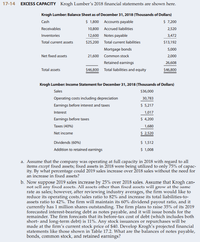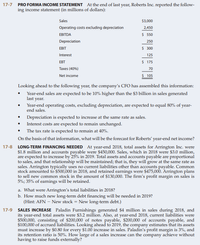
FINANCIAL ACCOUNTING
10th Edition
ISBN: 9781259964947
Author: Libby
Publisher: MCG
expand_more
expand_more
format_list_bulleted
Question

Transcribed Image Text:17-14 EXCESS CAPACITY Krogh Lumber's 2018 financial statements are shown here.
Krogh Lumber: Balance Sheet as of December 31, 2018 (Thousands of Dollars)
$ 1,800 Accounts payable
$ 7,200
Cash
Receivables
10,800 Accrued liabilities
2,520
Inventories
12,600 Notes payable
3,472
Total current assets
$25,200 Total current liabilities
$13,192
Mortgage bonds
5,000
Net fixed assets
21,600 Common stock
2,000
Retained earnings
26,608
$46,800 Total liabilities and equity
$46,800
Total assets
Krogh Lumber: Income Statement for December 31, 2018 (Thousands of Dollars)
Sales
$36,000
Operating costs including depreciation
30,783
Earnings before interest and taxes
$ 5,217
Interest
1,017
Earnings before taxes
$ 4,200
Taxes (40%)
1,680
$ 2,520
Net income
$ 1,512
$ 1,008
Dividends (60%)
Addition to retained earnings
a. Assume that the company was operating at full capacity in 2018 with regard to all
items except fixed assets; fixed assets in 2018 were being utilized to only 75% of capac-
ity. By what percentage could 2019 sales increase over 2018 sales without the need for
an increase in fixed assets?
b. Now suppose 2019 sales increase by 25% over 2018 sales. Assume that Krogh can-
not scll any fixcd assets. All assets other than fixed assets will grow at the same
rate as sales; however, after reviewing industry averages, the firm would like to
reduce its operating costs/sales ratio to 82% and increase its total liabilities-to-
assets ratio to 42%. The firm will maintain its 60% dividend payout ratio, and it
currently has 1 million shares outstanding. The firm plans to raise 35% of its 2019
forecasted interest-bearing debt as notes payable, and it will issue bonds for the
remainder. The firm forecasts that its before-tax cost of debt (which includes both
short- and long-term debt) is 11%. Any stock issuances or repurchases will be
made at the firm's current stock price of $40. Develop Krogh's projected financial
statements like those shown in Table 17.2. What are the balances of notes payable,
bonds, common stock, and retained earnings?

Transcribed Image Text:PRO FORMA INCOME STATEMENT At the end of last year, Roberts Inc. reported the follow-
ing income statement (in millions of dollars):
17-7
Sales
$3,000
Operating costs excluding depreciation
2,450
ЕВITDA
$ 550
Depreciation
250
EBIT
$ 300
Interest
125
EBT
$ 175
Taxes (40%)
70
Net income
$ 105
Looking ahead to the following year, the company's CFO has assembled this information:
• Year-end sales are expected to be 10% higher than the $3 billion in sales generated
last year.
Year-end operating costs, excluding depreciation, are expected to equal 80% of year-
end sales.
Depreciation is expected to increase at the same rate as sales.
Interest costs are expected to remain unchanged.
The tax rate is expected to remain at 40%.
On the basis of that information, what will be the forecast for Roberts' year-end net income?
17-8
LONG-TERM FINANCING NEEDED At year-end 2018, total assets for Arrington Inc. were
$1.8 million and accounts payable were $450,000. Sales, which in 2018 were $3.0 million,
are expected to increase by 25% in 2019. Total assets and accounts payable are proportional
to sales, and that relationship will be maintained; that is, they will grow at the same rate as
sales. Arrington typically uses no current liabilities other than accounts payable. Common
stock amounted to $500,000 in 2018, and retained earnings were $475,000. Árrington plans
to sell new common stock in the amount of $130,000. The firm's profit margin on sales is
5%; 35% of earnings will be retained.
a. What were Arrington's total liabilities in 2018?
b. How much new long-term debt financing will be needed in 2019?
(Hint: AFN – New stock = New long-term debt.)
17-9
SALES INCREASE Paladin Furnishings generated $4 million in sales during 2018, and
its year-end total assets were $3.2 million. Also, at year-end 2018, current liabilities were
$500,000, consisting of $200,000 of notes payable, $200,000 of accounts payable, and
$100,000 of accrued liabilities. Looking ahead to 2019, the company estimates that its assets
must increase by $0.80 for every $1.00 increase in sales. Paladin's profit margin is 3%, and
its retention ratio is 50%. How large of a sales increase can the company achieve without
having to raise funds externally?
Expert Solution
This question has been solved!
Explore an expertly crafted, step-by-step solution for a thorough understanding of key concepts.
This is a popular solution
Trending nowThis is a popular solution!
Step by stepSolved in 2 steps

Knowledge Booster
Learn more about
Need a deep-dive on the concept behind this application? Look no further. Learn more about this topic, accounting and related others by exploring similar questions and additional content below.Similar questions
- Alpesharrow_forwardAdditional information: 2018 current ratio: 1.4:1 debt to total assets: 61.1% Question: find working capital for 2018 Additional information: 2017 current ratio 1.5:1 working capital: 214,500 Question find debt to total assets for 2017arrow_forwardBalance Sheets 2019 2018 Assets Cash and equivalents $100 $85 Accounts receivable 275 300 Inventories 375 250 Total current assets $750 $635 Net plant and equipment 2,300 1,490 Total assets $3,050 $2,125 Liabilities and Equity Accounts payable $150 $85 Accruals 75 50 Notes payable 150 75 Total current liabilities $375 $210 Long-term debt 450 290 Total liabilities 825 500 Common stock 1,225 1,225 Retained earnings 1,000 400 Common equity 2,225 1,625 Total liabilities and equity $3,050 $2,125 Income Statements 2019 2018 Sales $2,065 $1,525 Operating costs excluding depreciation and amortization 1,250 1,000 EBITDA $815 $525 Depreciation and amortization 100 75 EBIT $715 $450 Interest 63 46 EBT $652 $404 Taxes (25%) 163 101 Net income $489 $303 Dividends paid $54 $48 Addition to…arrow_forward
- Philly Corporation Philly Corporation Income Statement Comparative Account Information Relating to Operations For the Year Ended December 31, 2020 For the Year Ended December 31, 2020 2020 2019 Sales Revenue 680,000 Accounts receivable -net 78,000 65,000 Cost of goods sold 355,000 Prepaid insurance 5,000 6,000 Salaries expense 50,000 Equipment 111,100 122,400 Depreciation expense equipment 6,800 Accumulated Depreciation 13,800 14,600 Interest expense 8,000 Land 56,000 36,000 Bad debt expense 2,400 Accounts Payable 59,000 47,000 Loss on sale of equipment 4,800 Interest payable 600 1,500 Miscellaneous…arrow_forwardCalculate the current ratio current assets/current liabilities for Castle rock construction round to one decimal place. The current ratio 2:1arrow_forwardCurrent fiscal year Accounts receivable: 4,532 Inventory: 5,372 Property, plant, and equipment, net: 9,178 Accounts payable: 3,183 Long-term debt: 14,001 Depreciation and amortization expense: 1,831 Net income: 5,791 The next year's forecasted balances for above accounts Accounts Receivable: 4,351 Inventory: 5,050 Property, plant, and equipment, net: 9,637 Accounts payable: 4,584 Long-term debt: 18,341 Depreciation and amortization expense: 1,977 Net income: 4,922 1. Using only the information given abouve what is the forecasted amount for Cash Flows from Operating Activities?arrow_forward
- Balance Sheet December 31, 2021 Current Assets: Cash 46,200 Accounts Receivable (net) 260,000 Raw materials inventory (4,500 yards) 11,250 Finished goods inventory (1,500 units) 32,250 Total current assets 349,700 Plant and equipment: Buildings and equipment 900,000 Accumulated depreciation (292,000) Plant and equipment, net 608,000 Total Assets 957,700 Liabilities and Stockholders' Equity Current liabilities: 158,000 Accounts Payable Stockholders' equity: Common stock 419,800 Retained earnings 379,900 Total stockholders; equty 799,700 Total liabilities and stockholder's equity 957,700 Additional Information The company's chief financial officer (CFO), in consultation with various managers across the organization has developed the following set of assumptions to help create the 2022 budget: 1 The budgeted unit sales are 12,000 units, 37,000 units, 15,000 units and 25,000 units for quarters 1-4, respectively. Notice that the company experiences peak sales in the second and fourth…arrow_forwardBalance Sheet December 31, 2021 Current Assets: Cash 46,200 Accounts Receivable (net) 260,000 Raw materials inventory (4,500 yards) 11,250 Finished goods inventory (1,500 units) 32,250 Total current assets 349,700 Plant and equipment: Buildings and equipment 900,000 Accumulated depreciation (292,000) Plant and equipment, net 608,000 Total Assets 957,700 Liabilities and Stockholders' Equity Current liabilities: 158,000 Accounts Payable Stockholders' equity: Common stock 419,800 Retained earnings 379,900 Total stockholders; equty 799,700 Total liabilities and stockholder's equity 957,700 Additional Information The company's chief financial officer (CFO), in consultation with various managers across the organization has developed the following set of assumptions to help create the 2022 budget: 1 The budgeted unit sales are 12,000 units, 37,000 units, 15,000 units and 25,000 units for quarters 1-4, respectively. Notice that the company experiences peak sales in the second and fourth…arrow_forwardPrivett Company Line Item Description Amount Accounts payable $27,815 Accounts receivable 70,978 Accrued liabilities 6,525 Cash 22,970 Intangible assets 43,640 Inventory 74,446 Long-term investments 100,209 Long-term liabilities 78,528 Marketable securities 34,768 Notes payable (short-term) 25,264 Prepaid expenses 2,065 Property, plant, and equipment 646,687 Based on the data for Privett Company, what is the amount of working capital? a. $205,227 b. $995,763 c. $128,716 d. $145,623arrow_forward
- MOSS COMPANY Selected Balance Sheet Information 2020 At December 31 Current assets Cash Accounts receivable. Inventory Current liabilities. Accounts payable Income taxes payable $ 84,650 25,000 60,000 Sales Cost of goods sold Gross profit 30,400 2,050 2019 $26,800 32,000 54,100 MOSS COMPANY Income Statement For Year Ended December 31, 2020 25,700 2,200 Operating expenses (excluding depreciation) Depreciation expense Income before taxes Income taxes expense Net income $ 515,000 331,600 183,400 121,500 36,000 25,900 7,700 $ 18,200 Use the information above to calculate cash flows from operating activities using the indirect method. Note: Amounts to be deducted should be indicated by a minus sign. Cash flows from operating activities: Adjustments to reconcile net income to net cash provided by operating activitiesarrow_forwardBALANCE SHEET AT END OF YEAR (Figures in $ millions) Assets 2021 2022 Liabilities and Shareholders' Equity 2021 2022 Current assets $ 102 $ 200 Current liabilities $ 74 $ 96 Net fixed assets 920 1,020 Long-term debt 660 870 INCOME STATEMENT, 2022 (Figures in $ millions) Revenue $ 2,010 Cost of goods sold 1,090 Depreciation 410 Interest expense 252 g. Net fixed assets increased from $920 million to $1,020 million during 2022. What must have been South Sea’s gross investment in fixed assets during 2022?........... (M1)arrow_forwardBalance Sheets as of December 31, 2015 and 2016 2015 2016 2015 2016 Assets Liabilities and Owners' Equity Cash Accounts receivable Inventory Net fixed assets 21,900 24,300 Common stock $ 850 $ 1,210 126 Accounts payable 1,370 Short-term notes payable $ 1,080 $ 970 500 0 4,350 4,610 Long-term debt 11,900 13,500 6,000 6,200 Retained earnings Total assets $28,310 $30,406 Total liabilities and owners' equity 8,830 $28,310 $30,406 9,736 2016 Income Statement Sales Cost of goods sold Depreciation Interest Taxes Net income $30,710 18,470 6,132 744 1,824 $ 3,540 What are the values of the three components of the DuPont identity? Use ending balance sheet values. Multiple Choicearrow_forward
arrow_back_ios
SEE MORE QUESTIONS
arrow_forward_ios
Recommended textbooks for you

 AccountingAccountingISBN:9781337272094Author:WARREN, Carl S., Reeve, James M., Duchac, Jonathan E.Publisher:Cengage Learning,
AccountingAccountingISBN:9781337272094Author:WARREN, Carl S., Reeve, James M., Duchac, Jonathan E.Publisher:Cengage Learning, Accounting Information SystemsAccountingISBN:9781337619202Author:Hall, James A.Publisher:Cengage Learning,
Accounting Information SystemsAccountingISBN:9781337619202Author:Hall, James A.Publisher:Cengage Learning, Horngren's Cost Accounting: A Managerial Emphasis...AccountingISBN:9780134475585Author:Srikant M. Datar, Madhav V. RajanPublisher:PEARSON
Horngren's Cost Accounting: A Managerial Emphasis...AccountingISBN:9780134475585Author:Srikant M. Datar, Madhav V. RajanPublisher:PEARSON Intermediate AccountingAccountingISBN:9781259722660Author:J. David Spiceland, Mark W. Nelson, Wayne M ThomasPublisher:McGraw-Hill Education
Intermediate AccountingAccountingISBN:9781259722660Author:J. David Spiceland, Mark W. Nelson, Wayne M ThomasPublisher:McGraw-Hill Education Financial and Managerial AccountingAccountingISBN:9781259726705Author:John J Wild, Ken W. Shaw, Barbara Chiappetta Fundamental Accounting PrinciplesPublisher:McGraw-Hill Education
Financial and Managerial AccountingAccountingISBN:9781259726705Author:John J Wild, Ken W. Shaw, Barbara Chiappetta Fundamental Accounting PrinciplesPublisher:McGraw-Hill Education


Accounting
Accounting
ISBN:9781337272094
Author:WARREN, Carl S., Reeve, James M., Duchac, Jonathan E.
Publisher:Cengage Learning,

Accounting Information Systems
Accounting
ISBN:9781337619202
Author:Hall, James A.
Publisher:Cengage Learning,

Horngren's Cost Accounting: A Managerial Emphasis...
Accounting
ISBN:9780134475585
Author:Srikant M. Datar, Madhav V. Rajan
Publisher:PEARSON

Intermediate Accounting
Accounting
ISBN:9781259722660
Author:J. David Spiceland, Mark W. Nelson, Wayne M Thomas
Publisher:McGraw-Hill Education

Financial and Managerial Accounting
Accounting
ISBN:9781259726705
Author:John J Wild, Ken W. Shaw, Barbara Chiappetta Fundamental Accounting Principles
Publisher:McGraw-Hill Education